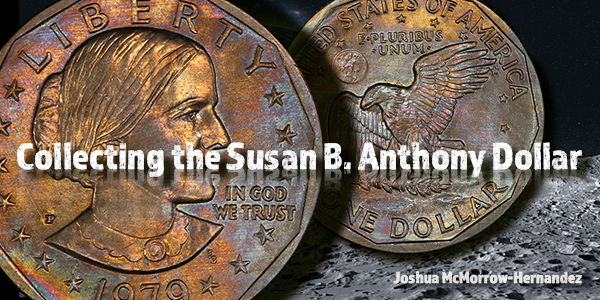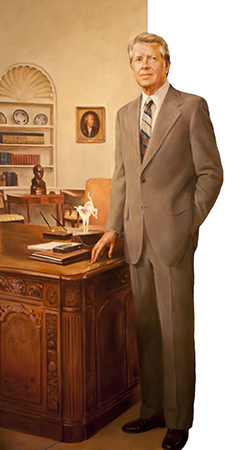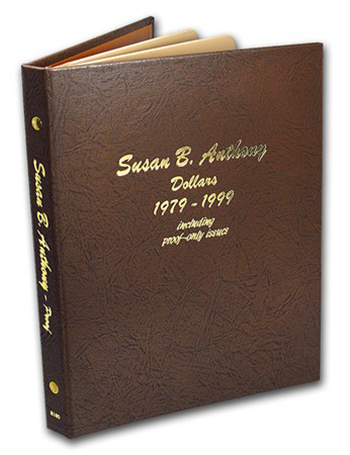
By Joshua McMorrow-Hernandez for CoinWeek.com ……
Susan B. Anthony dollars are growing on some collectors these days. Now gracefully approaching middle age, the nation’s first small-size dollar coin series, which lasted from 1979 until 1981 and reappeared for a stray stint in 1999, hearkens to a relatively quainter time in American numismatics.
The first Susan B. Anthony dollars hit the streets before third-party coin certification took over the industry. Back then, the United States Mint issued only a manageable handful of annual products (traditional mint sets and proof sets, anyone?). Even the modern commemorative coin program was just a glint in the eyes of a few congressional visionaries. It was a different time in American numismatics.
Now, the much-maligned coin that many collectors once ardently disowned and virtually all of the public refused to accept as circulating currency is gaining some luster. Like Eisenhower dollars in years past, the general opinion on copper-nickel clad Susan B. Anthony dollars is evolving in the numismatic world. Some collectors are seeing something special in the stagflation-era coin, which honors the famous women’s rights pioneer. The coin, whose original run came and went during the era of the Equal Rights Amendment, was derided by many as the “Carter Quarter”.
That particular tongue-in-cheek pejorative has its roots in the sustained inflation that coincided with President Jimmy Carter’s single term in the White House from 1977 through 1981. That, and the fact that the coin was sometimes mistakenly traded in commerce as a quarter due to its similar diameter, thickness, and color. This left some frustrated individuals 75 cents (or more) short after a cash transaction involving the new dollar coin.
Therefore it’s little wonder, perhaps, that the Susan B. Anthony dollar barely survived the duration of its short-lived television contemporary B.J. and the Bear and not even nearly as long as America’s momentary love affair with the metric system.
Of course, Susie B returned in 1999, but that 41.4 million business-strike production run was largely to fill a demand for hard money at a time when the predicted (but thankfully unfulfilled) Y2K crisis threatened computerized banking systems. There was also a reported shortfall of dollar coins in the mass transit and vending machine circuit[1]. Temporarily reviving the Susan B. Anthony dollar in 1999 was ostensibly the most viable solution to meet circumstantial needs before the Sacagawea golden dollar coin could legally be struck in 2000.
The Dansco Set Versus a Registry Set
If there was any love lost for the Susan B. Anthony dollar in the disco era, it was found once again in the Facebook era. In recent years, many collectors have turned to building sets of Susan B. Anthony dollars. One of the latest publications to hit bookstores, A Guide Book of Modern United States Dollar Coins (2016) by Q. David Bowers, has helped to fuel more numismatic interest than ever in the first and so far only copper-nickel small dollar series issued by the United States.
Popular album manufacturers such as Dansco offer deluxe display options for Susan B. Anthony dollars, and many SBA enthusiasts have turned to the registry set arena to build top-grading collections of certified, super-grade Anthony dollars. Both the standard Dansco and registry set collections include all 12 of the regular-issue SBAs plus the six proof varieties. These include the following:

Mintages sourced from A Guide Book of United States Coins, by R.S. Yeoman and Kenneth Bressett (Whitman Publishing)
The overall number of issues required to finish a Dansco #8180 Susan B. Anthony dollar album and Professional Coin Grading Service (PCGS) or Numismatic Guaranty Corporation (NGC) Susan B. Anthony dollar registry set, which includes major varieties, circulation strikes, and proof issues is the same, at 18 coins each, the challenges in completing one over the other may seem like night and day. On the surface, it seems that either collecting approach should present a roughly equal challenge, as both the Dansco album and registry set require the same exact issues and varieties.
In theory they should… until the overarching objective of building a registry set becomes clearer. After all, the goal for most registry set collectors is to obtain the very best coins possible to achieve the highest overall average grade among all collectors registering their sets for that series. PCGS ranks registry sets by awarding each set a grade point average (GPA) based on the numerical grade point of each coin in the set.
For example, the top-ranking registry set for Susan B. Anthony dollars, in which each of the 18 coins are among the very highest grade presently awarded (including, in the case, the only-known 1979-P narrow rim dollar graded MS-68 by PCGS, with none graded higher), has a weighted GPA of 68.71. Including GPA bonuses for low-population, top-graded coins, the highest-graded Susan B. Anthony dollar set has a total GPA of 69.71. The set, which has won awards each year from 2012 through 2016, presently ranks more than two-tenths of a point ahead of the second-ranking Susan B. Anthony dollar registry set.
The Susan B. Anthony Dollar Registry Set
 To beat the top-ranking Susan B. Anthony dollar registry set, one would have to not only cobble together the highest-graded PCGS examples of all 18 Susie Bs, but they also need to pepper the set with at least one or two top-grading dollars surviving as the only known specimens in their grade, with none ranking higher. Even with all of the money in the world, accomplishing this is no easy feat. Try wrestling away a few top-population, sole surviving SBA dollars from an enthusiast.
To beat the top-ranking Susan B. Anthony dollar registry set, one would have to not only cobble together the highest-graded PCGS examples of all 18 Susie Bs, but they also need to pepper the set with at least one or two top-grading dollars surviving as the only known specimens in their grade, with none ranking higher. Even with all of the money in the world, accomplishing this is no easy feat. Try wrestling away a few top-population, sole surviving SBA dollars from an enthusiast.
Making the completion of a top-ranked registry set collection even more challenging is locating a few of those “top-pop” coins. Consider, for example, the case of the 1981-S business-strike Susan B. Anthony dollar.
Unlike the 1979 and 1980 SBAs, which were mostly struck for circulation, all 1981 dollars were struck for numismatic purposes only, and the entire mintage of 1981 SBAs was slated for collector sets. En route from San Francisco to Denver for packing in red-striped Denver mint set cellophane packaging, the 1981-S dollars were banged up in transit[2] .
Making matters even more challenging for individuals who seek a nice 1981-S dollar is the fact that collectors can’t search through $1,000 bag quantities. While surpluses of earlier issues were made available to the public in $1,000 bags (in which many collectors found top-grading specimens), there were no 1981 dollars issued in such bag quantities. The incredible rarity of high-grade 1981-S Susan B. Anthony dollars is reflected in PCGS population figures, which indicate only three specimens in the top-known grade of MS-67. The coin is scarce even in MS-66, with only 126 PCGS-graded specimens[3].
The 1981-S dollar, with only 3,492,000 examples struck, boasts the third-lowest mintage of the series, with the 1981-P ranking as the lowest with only three million pieces made. Interestingly, the 1981-P dollar isn’t necessarily much easier to find in MS-67, the top grade in a PCGS slab for that issue. Only 18 have been graded by PCGS in MS-67, and just 307 are known in MS-66[4].
Also ranking as scarce is the only major business-strike variety: the 1979-P Wide Rim dollar. This coin, on which the date nearly touches the rim, was introduced in late 1979 and showcases a design modification that was used for the remainder of the series. The 1979-P Wide Rim is much scarcer than its 1979-P “Narrow Rim” counterpart. PCGS estimates that just 20,000 examples of the 1979-P Wide Rim dollar exist, and they command substantial premiums over the normal 1979-P dollar variety, which shows substantial separation between the rim and the coin’s date. PCGS reports the highest-graded 1979-P Wide Rim dollars are certified MS-67, and only 17 pieces are known in that grade[5].
The highest-grading business-strike Susan B. Anthony dollars graded by PCGS are certified MS-68 and include the 1979-P, 1979-S, 1980-P, 1999-P, and 1999-D dollars. While none of the business-strikes are certified in MS-69 or MS-70, each of the six proof issues is represented by survivors grading as high as Proof-70 Deep Cameo.
Building an SBA Dansco Set
The remarkable difficulty in finding registry set-quality Susan B. Anthony dollars stands in sharp contrast to the relative ease one is sure to enjoy in filling the 18-piece Dansco #8180 album. While a collector may personally desire to seek only the highest-quality coins for their collection, there is not necessarily any external pressure to find only top-grading certified coins for a more conventional album collection, as would likely be the case if he or she were building a registry set.
 Choice or gem uncirculated and proof specimens are sufficient for a “typical” Dansco-housed Susan B. Anthony dollar set. Therefore, the price of building such a collection is only a fraction of the cost of assembling a top-tier registry set collection, and the set can generally be completed in much less time. Even with the absence of grade-point minimums, the most challenging coins will still be the scarce varieties. These include the 1979-P Wide Rim, 1979-S Type II proof, and 1981-S Type II proof, but these issues are nevertheless widely available for a cost.
Choice or gem uncirculated and proof specimens are sufficient for a “typical” Dansco-housed Susan B. Anthony dollar set. Therefore, the price of building such a collection is only a fraction of the cost of assembling a top-tier registry set collection, and the set can generally be completed in much less time. Even with the absence of grade-point minimums, the most challenging coins will still be the scarce varieties. These include the 1979-P Wide Rim, 1979-S Type II proof, and 1981-S Type II proof, but these issues are nevertheless widely available for a cost.
Complete 18-piece Susan B. Anthony dollar sets are offered by many coin dealers, and they are also commonly found on eBay. The 18-coin SBA Dansco sets are typically offered on the online marketplace for between $250 and $400 (for typical examples, click here, here or here).
For those who enjoy the challenge of building a Dansco collection from scratch, finding suitable uncirculated and proof singles may be the biggest hurdle. Many coin dealers don’t stock individual Anthony dollars, and those who do may not necessarily have all of the varieties on hand. In many cases, when SBA dollar varieties are sold as singles, they are in third-party slabs. This leaves the collector with the following dilemma: to crack out or not to crack out?
This is a decision the collector must make on his or her own. Many collectors forming album-based collections will crack out coins from their slabs to fill respective album holes, but that may also compromise the resale value of those formerly certified coins. Some SBA enthusiasts leave their slabbed Susie Bs in their sonically sealed plastic holders and bundle the slabs with the album to keep the series collection together.
Completing a Dansco collection of Susan B. Anthony dollars can be a rewarding accomplishment. The set can stand alone nicely in a collection. However, some hobbyists assemble SBA sets within the grander scheme of a larger collection of other modern dollar coins, including the Eisenhower dollar (1971-78), the Sacagawea dollar (2000-2008), Presidential $1 coins (2007-2016), and the Native American dollar (2009-present).
The Future of Collecting Susan B. Anthony Dollars
The passage of time has been increasingly kinder to the Susan B. Anthony dollar. Those who remember the series’ widely broadcast failure in the public arena as a circulating coin are now looking back with nostalgia. Others who were too young to remember the Anthony dollar’s plunge from grace often view the coin less as a public nuisance and more as a novelty of sorts. For many younger collectors who remember the coin in the late 1970s, ’80s, or ’90s, the Susan B. Anthony dollar was often seen as an unusual piece among the more familiar Lincoln Memorial cents, Jefferson nickels, Roosevelt dimes, and Washington quarters.
As the Anthony dollar moves beyond its decades-long stay in numismatic purgatory, it just may become “the little dollar that could”–if not as a circulating coin then as a popular collectible. Collecting the short-run series encompassing only 18 coins (including proofs and major varieties) is an alluring prospect for many collectors who wish to assemble an affordable, accessible series set. Collectors who take on the challenge of the Susan B. Anthony dollar registry set may find that now is the time to act, before potentially many more SBA enthusiasts put pressure on the truly scarce coins. Low populations in the top-end grades may beckon to action opportunistic collectors who believe there are still deals to be had in high-quality Susan B. Anthony dollars – coins that might one day become hotter commodities than anyone could presently imagine.
* * *
Notes
[1] https://www.ngccoin.com/coin-explorer/susan-b-anthony-dollars-1979-1999-pscid-52
[3] http://www.pcgscoinfacts.com/Coin/Detail/9580
[4] http://www.pcgscoinfacts.com/Coin/Detail/9578
[5] http://www.pcgscoinfacts.com/Coin/Detail/99571





You mentioned NGC when first discussing a Dansco set versus a Registry set but later in the article when sharing the populations of some of the harder to come by coins, you only provide the number graded by PCGS.
For example, “The incredible rarity of high-grade 1981-S Susan B. Anthony dollars is reflected in PCGS population figures, which indicate only three specimens in the top-known grade of MS-67. The coin is scarce even in MS-66, with only 126 PCGS-graded specimens.” The NGC Census for that same coin is four graded in MS-67 and 113 in MS-66.
Additionally, “Interestingly, the 1981-P dollar isn’t necessarily much easier to find in MS-67, the top grade in a PCGS slab for that issue. Only 18 have been graded by PCGS in MS-67, and just 307 are known in MS-66.” The NGC Census for that same coin is 76 graded in MS-67 and 437 in MS-66.
Finally, “PCGS reports the highest-graded 1979-P Wide Rim dollars are certified MS-67, and only 17 pieces are known in that grade.” The NGC Census for that same coin is 51 graded in MS-67.
Even with those numbers combined, they certainly remain a low overall population but adding the other top TPG numbers does put a bit a of different lens on the story (or sense of urgency in collecting those particular specimens). Is PCGS the preferred TPG when discussing Registry sets? Just curious.
In retrospect the hapless Anthony dollar seems to be almost a case study in how NOT to design a coin. The combination of Mint blunders and Congressional meddling doomed it from the start.
Early plans to use multi-sided planchets were shelved, reportedly because people at the Mint claimed it would be too difficult – despite the fact that numerous other countries had used similar planchets for decades. Frank Gasparro’s warnings about size and color were ignored, and the Mint failed to heed the almost-identical débacle of the 20¢ coin a century before. Congress’ failure to discontinue printing $1 bills and increase production of $2 notes gave consumers neither reason nor alternatives to their use of paper bills. Canada, of course, learned from our missteps and successfully introduced its Loonie less than a decade later.
On a side note as a former math teacher, we didn’t so much have a “love affair” with metrication as it was a necessary step to help bring our economy into line with the majority of other nations. Both the US and Canada agreed to a multi-stage conversion plan; however while Canada’s had goals and deadlines ours was completely voluntary. Like the dollar coin there were few or no incentives to change so most of the economy stayed with feet, pounds, and gallons.
Unfortunately the program’s formal demise in the US can be laid directly at the feet of politicians whose opposition derailed it after the 1980 elections. Later analyses indicated that their failure has quite literally cost us hundred of billions of dollars in lost trade.